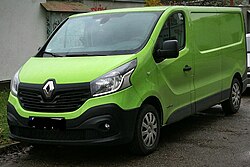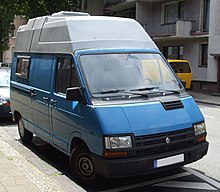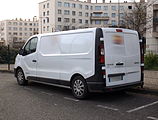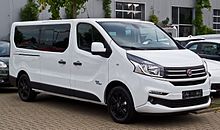Renault Trafic
| Renault Trafic | |
|---|---|
| Manufacturer: | Renault |
| Production period: | 1980 – today |
| Previous model: | Renault Estafette |
| Successor: | none |
The Renault Trafic is a minibus / vans the French brand Renault . Light commercial vehicles with this name have been in the Renault range since the summer of 1980. The first generation was manufactured by the Société des Véhicules Automobiles de Batilly .
Thanks to the new cooperation partner General Motors Europe, the second generation has now also been built as an Opel Vivaro or Vauxhall Vivaro. After the launch of the Trafic II and the Opel Vivaro, both were voted Van of the Year in 2002. Due to the Franco-Japanese alliance Renault-Nissan , the van was also marketed as the Nissan Primastar . Both the Trafic II, the Nissan Primastar and the GM variants were produced at GM Manufacturing Luton .
The third generation, which will be available from 2014, is now partly produced again by Renault at its plant in Sandouville near Le Havre , while the Primastar is now being produced as the Nissan NV300 at Nissan Motor Ibérica . In 2015 a new cooperation partner was found in Fiat . The Trafic / Vivaro / NV300 was also produced as a Fiat Talento from 2016.
In the second quarter of 2019, Opel ended its cooperation with Renault after 18 years, as the German vehicle manufacturer was taken over by its competitor PSA in August 2017 and the GM platforms could no longer be used by Opel for licensing reasons.
Traffic I (1980-2001)
| 1st generation | |
|---|---|

Renault Trafic box high roof (1994-2001) |
|
| Production period: | 1980-2001 |
| Designs: | Panel vans , flatbed trucks , minibuses |
| Engines: |
Otto engines : 1.4–2.2 liters (35–74 kW) Diesel engines : 1.9–2.5 liters (44–55 kW) |
| Length: | 4337-4434 mm |
| Width: | 1905 mm |
| Height: | 2037 mm |
| Perm. Total weight: | 2.8-3.5 t |
When it appeared in the summer of 1980, the newly designed Renault Trafic replaced the predecessor Estafette .
The Trafic was designed for the weight class 2.1 to 2.8 tons total weight. At the same time, the technically closely related larger Renault Master for 2.8 to 3.5 tons was introduced. The mix of front-wheel and rear-wheel drive was unusual in vans. There was the Trafic-T ( Traction (avant) = front-wheel drive) for passenger transport / minibus as "Microbus Comfort" and the Trafic-P ( Propulsion (arrière) = rear-wheel drive) as a small van and platform truck. From mid-1985 the Renault Trafic was also offered with all-wheel drive. The master had rear wheel drive. The curb weight is given as 1200-1300 kg.
It was available with gasoline engines with outputs between 35 kW and 59 kW or diesel engines with 44 kW and 49 kW. As was common in this segment at that time, the vehicles had a very angular shape.
Like the Ford Transit from 1965 and the Mercedes-Benz T 1 (“Bremer Transporter”) from 1977, the new model was no longer a front-wheel drive like its predecessor, but with a short hood in front of the driver's seat row, under which the engine and transmission could be found. This hood was aerodynamically shaped rising continuously above the radiator grille and formed a line with the windshield up to the roof.
The van- like front made of sloping bonnet and windshield was aerodynamically improved after a facelift in May 1989 and adapted to contemporary tastes with more rounded shapes. The engine output increased and there was now also a diesel engine with 55 kW and a gasoline engine with 70 kW.
A second facelift took place in June 1994 with a change in the range of engines. There were only two diesels with 48 kW and 55 kW and a gasoline engine with 74 kW on offer.
From mid-1997, the Renault Trafic was taken over under license by General Motors with minor modifications , when this manufacturer wanted to offer small vans again after a long break. The model was sold under the name Opel Arena , in the British Isles as the Vauxhall Arena and as the Chevrolet Space Van in Brazil.
The Tata Winger , built by Tata Motors in India since 2007, is largely based on the Trafic I.
Trafic II (2001-2014)
| 2nd generation | |
|---|---|

Renault Trafic Combi (2001-2006) |
|
| Production period: | 2001-2014 |
| Designs: | Panel vans , flatbed trucks , minibuses |
| Engines: |
Otto engine : 2.0 liters (88 kW) Diesel engine : 1.9–2.5 liters (66–107 kW) |
| Length: | 4782-5182 mm |
| Width: | 1900-2232 mm |
| Height: | 1915-1980 mm |
| Wheelbase: | 3098-3498 mm |
| Perm. Total weight: | 2.8-3.5 t |
| Stars in the Euro NCAP - Crash Test (2012) |
|
In September 2001 the second generation of the Trafic was presented. Like the Renault Master since the end of 1997, this is also a joint product of Renault - Nissan and Opel . Its sister models are called Opel Vivaro (since 2001) and Nissan Primastar (since 2002). The curb weight is given as 1785–1976 kg.
Renault developed the Trafic in collaboration with General Motors. It rolls off the assembly line at GM Europe's Luton plant in Great Britain and at the alliance partner Nissan's plant in Barcelona. Renault has been the market leader in Western Europe among manufacturers of light commercial vehicles up to 3.5 tonnes gross vehicle weight since 1998.
The front of the vehicle became visually more rounded and the body shape with downward / inward teardrop-shaped headlights, a dome over the driver and front passenger seat and rear lights embedded in the plastic-clad body edges, it looks quite futuristic, with slightly increased payloads of 1000 and 1200 kg optically a bit smaller than its predecessor. The Trafic is built in the normal length version L1 (4782 mm) and the long version L2 with 400 mm more length in the last section of the vehicle in front of the rear wheel arches.
Engines
The Trafic II was offered with gasoline and diesel engines. The 1.9 liter common rail diesel was available in two output levels. Both engines met the Euro 3 emissions standard.
- 2.0 16S, four-cylinder gasoline engine with 1998 cm³ displacement and 88 kW (120 PS), 2001-2006
- 1.9 dCi 80, four-cylinder diesel engine with 1870 cm³ displacement and 60 kW (82 PS), 2001-2006
- 1.9 dCi 100, four-cylinder diesel engine with 1870 cm³ displacement and 74 kW (101 hp), 2001-2006
- 2.5 dCi 140, four-cylinder diesel engine with 2463 cm³ displacement and 99 kW (135 PS), 2001-2006
In summer 2006 the Trafic received a slight facelift and technical changes. A quick-shift transmission (6-speed) was introduced. The lowest engine size starts at 66 kW (90 PS). The two less powerful units have been expanded from 1.9 to 2.0 liters and achieve Euro 4 without a particle filter. The 1.9-liter engine is only installed in the old models, which are sold in Eastern Europe as the Lada Renault M90 . Furthermore, the previous 2.5-liter diesel engine with 99 kW was increased to 107 kW in order to compensate for the loss in this engine due to the particulate filter required for Euro 4 .
From 2006 Renault offered the Trafic II with the 2.0-liter common-rail diesel engine, which was available in two power levels. Both engines met the Euro 5 emissions standard.
- 2.0 16V, four-cylinder petrol engine with 1998 cm³ displacement and 86 kW (117 PS), 2006–2008
- 2.0 dCi 90, with 66 kW (90 PS), 240 Nm at 1600 rpm, 2006–2014
- 2.0 dCi 115, with 84 kW (114 PS), 290 Nm at 1600 rpm, 2006-2014
- 2.5 dCi 150 FAP, with 107 kW (146 PS), 320 Nm at 1500 rpm, 2006-2014
Production of the second Trafic ended in August 2014.
Equipment
The Trafic is available both in a car version with up to nine seats and as a commercial vehicle. Depending on the engine, wheelbase and payload class, a total of 40 versions are available. Renault offers the Trafic as a panel van and a double-cab panel van with two wheelbases each (3,098 and 3,498 millimeters). In addition to the 1.98 meter high normal version, the panel van also has a high roof version (2.50 meters).
As a passenger car, Renault offers the Trafic in the three body styles Combi , Passenger Black Edition and Generation Evado .
The Trafic Combi focuses on functionality and offers eight seats as standard (partially glazed: six seats). It is particularly suitable for the commercial transport of people and goods.
The Passenger Black Edition is particularly noticeable with its tinted rear and side windows.
Trafic Evado
This variant with three common rail turbodiesel engines between 84 kW and 107 kW has been available for large families since 2008. The engines work with a six-speed gearshift or as a six-speed automatic.
Trafic III (since 2014)
| 3rd generation | |
|---|---|

Renault Trafic III (2014-2019) |
|
| Production period: | 2014– |
| Designs: | Panel vans , flatbed trucks , minibuses |
| Engines: |
Diesel engine : 1.6–2.0 liters (70–125 kW) |
| Length: | 4999-5399 mm |
| Width: | 1956 mm |
| Height: | 1971 mm |
| Wheelbase: | 3098-3498 mm |
| Stars in the Euro NCAP - Crash Test (2015) |
|
The Renault Trafic III has been in production since September 2014. The third generation of the Renault Trafic is mainly manufactured by Renault at the Sandouville plant in France, while the Opel Vivaro B continued to be produced at the GM plant in Luton until March 2019. As with the previous model, a Nissan model based on the Renault Trafic is offered which was given the designation Nissan NV300 .
Compared to its predecessor, a new front was developed with improved pedestrian protection in the event of a collision and a reduction in the c w value . In addition to the changed design of the vehicle, the door handles are now arranged horizontally.
Smartphones, tablets and laptops can now be controlled using a 7-inch touchscreen display integrated in the dashboard (available at an extra charge). A reversing camera is also available. Thanks to a special design of the partition, objects up to 4.15 meters long can now be stowed in the cargo area and under the front passenger seat.
There are Trafic campers called 'Kompanja' and 'Colibri'.
The facelift model of the Trafic was presented on April 23, 2019. It hit the market in the third quarter of 2019.
Changes:
- newly designed front
- more powerful engines, all meet the Euro 6d temp standard
- new steering wheel
- new information
Body styles
Available truck variants are panel vans, double cabs and platform chassis. The station wagon can be bought as a car.
Technical specifications
| dCi 95 | dCi 115 (Turkey, Ukraine) |
dCi 125 | dCi 140 (Turkey, Ukraine) |
dCi 145 | dCi 120 | dCi 145 | dCi 170 | |
|---|---|---|---|---|---|---|---|---|
| Engine characteristics | ||||||||
| since 2014 | 2014-2019 | since 2014 | 2014-2019 | since 2019 | ||||
| Engine type | R4 diesel engine | |||||||
| Engine charging | turbocharger | Twin turbocharger | turbocharger | turbocharger | turbocharger | |||
| Displacement | 1598 cc | 1997 cc | ||||||
| Max. Power at min −1 | 70 kW (95 PS) / 3500 | 85 kW (115 PS) / 3500 | 92 kW (125 PS) / 3500 | 103 kW (140 PS) / 3500 | 107 kW (145 PS) / 3500 | 88 kW (120 PS) / 3500 | 107 kW (146 PS) / 3500 | 125 kW (170 PS) / 3500 |
| Max. Torque in min -1 | 260 Nm / 1500 | 300 Nm / 1500 | 320 Nm / 1750 | 340 Nm / 1500 | 340 Nm / 1750 | 320 Nm / 1500 | 350 Nm / 1500 | 380 Nm / 1500 |
| Power transmission | ||||||||
| drive | Front wheel drive | |||||||
| Gearbox, as standard | 6-speed manual transmission | |||||||
| Readings | ||||||||
| Top speed | 153 km / h | 168 km / h | 169 km / h | 181 km / h | 177 km / h | 165 km / h | 176 km / h | |
| Acceleration, 0-100 km / h | 15.9 s | 12.4 s | 11.8 s | 10.8 s | 11.1 s | 11.9 s | ||
| Empty weight | 1872-1913 kg | 1901 kg | 1882-1923 kg | 1901 kg | 1882-1923 kg | 1805 kg | 1836 kg | |
| Fuel consumption over 100 km (combined) | 6.0 l diesel | 6.6 l diesel | 5.6 l diesel | 6.2 l diesel | 5.9 l diesel | 5.4-5.5 l diesel | 5.8-5.9 l diesel | |
| CO 2 emissions (combined) | 155 g / km | 174 g / km | 145 g / km | 164 g / km | 152 g / km | 144-146 g / km | 143-156 g / km | 146-156 g / km |
| Tank capacity | 80 l | |||||||
| Emission standard | Euro 6 / Euro 6c (since 2019) | 5 euro | Euro 6 | 5 euro | Euro 6 | Euro 6d-TEMP | ||
Fiat Talento
Since 2016 the Renault Trafic has also been produced as a Fiat Talento. Fiat replaces the Fiat Scudo with the model . In the first sales year of 2016, 349 Talento cars and 469 Talento trucks were registered in the Federal Republic of Germany. In 2017 there were 1268, 2018 1373 and 2019 1722 cars.
Web links
Individual evidence
- ↑ New Trafic 2014 from Sandouville ( Memento of the original from May 14, 2013 in the Internet Archive ) Info: The archive link was inserted automatically and has not yet been checked. Please check the original and archive link according to the instructions and then remove this notice.
- ↑ Renault Trafic II - AutoWiki. Retrieved October 20, 2017 (Finnish).
- ↑ New generation from 9/2014: auto-motor-und-sport.de
- ↑ Result of the Renault Trafic in the Euro NCAP crash test (2015)
- ↑ a b Uli Baumann: New Renault Trafic: Generation change in early summer - auto motor und sport. In: auto-motor-und-sport.de. June 16, 2014, accessed April 22, 2018 .
- ↑ Guido Bork: Driving report Nissan NV300 panel van: Four wins - Eurotransport. In: eurotransport.de. November 15, 2015, accessed April 22, 2018 .
- ↑ Martin Schou: Renault Trafic model check: Concentrated on the essentials - company car. In: firmenauto.de. August 7, 2015, accessed on April 22, 2018 (Equipment and Comfort section).
- ↑ The Renault Trafic Camper. Retrieved October 30, 2018 (German).
- ↑ www.karmann-mobil.de
- ↑ New registrations of passenger cars in December 2016 by brand and model series. (PDF) Retrieved December 8, 2017 .
- ↑ New registrations of motor vehicles and motor vehicle trailers by manufacturer and trade name in 2016. (PDF) Accessed on January 13, 2018 .
- ↑ New registrations of passenger cars in December 2017 by brand and model series. Retrieved January 9, 2018 .
- ↑ New registrations of passenger cars in December 2018 by brand and model series. Retrieved January 18, 2018 .
- ↑ New registrations of passenger cars in December 2019 by brand and model series. Retrieved January 11, 2019 .








